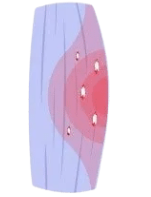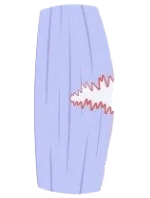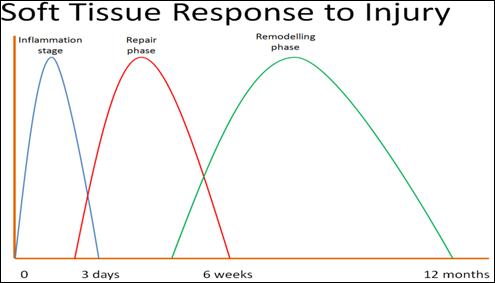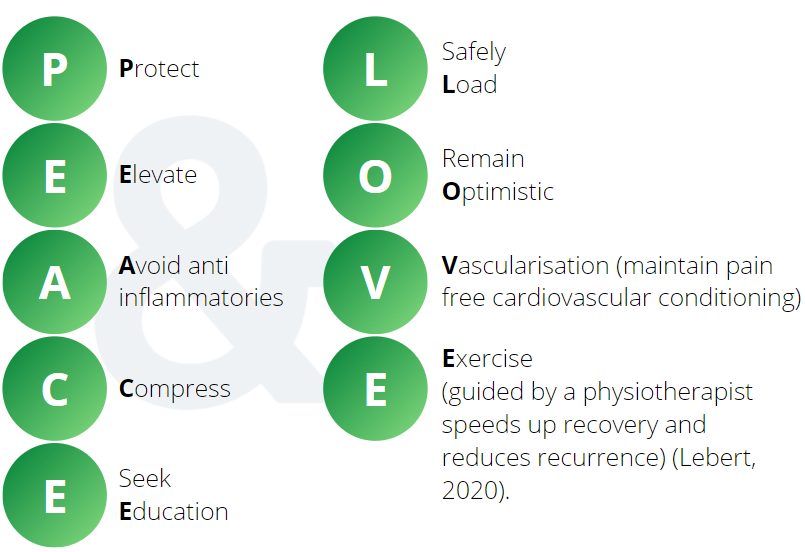Tears (often called sprains) occur when a sudden and forceful movement over a joint causes the ligament fibres to stretch beyond their capacity and tear. This leads to bleeding and an immediate inflammatory response (pain and swelling).
Accurate grading and diagnosis is important for prognosis, treatment and recovery.
Ligament tears are most common in the ankle, and usually occur while running, going down stairs, stepping on an uneven surface or landing on the outside of the foot, making it roll or twist inward into inversion.

Grading of Ligament Tears

Grade 1: Small amount of torn fibres. No laxity/instability on testing.

Grade 2: Partial tear/rupture with a moderate percentage of fibres torn. Laxity present on testing but no joint instability/mild instability noted. Swelling and often bruising apparent.

Grade 3: Complete tear/rupture of the ligament with instability and no end point on testing. Very swollen and bruised.
Stage 1: Inflammatory Phase (0-96 hours)
The damaged tissue is filled immediately with chemicals that produce pain, bleeding and an inflammatory response causing swelling to occur.
Stage 2: Repair Stage (2 days – 6 weeks)
Cells are released to attempt to heal the damaged ligament. Scar tissue is formed in an attempt to mesh the damaged ends of the torn ligament fibres together. The scar tissue however does not form in it’s normal parallel direction but in a disorganised mesh. As stress/load is applied to the healing ligament the strength of the ligament is increased.
Stage 3: Maturation/Remodelling (4 weeks – 12 months)
This stage involves the realignment of scar tissue into normal ligament tissue and assumes the structure of pre-injured tissue. The severity of the initial injury and the amount of time before commencing rehabilitation will influence the time taken for complete ligament healing and whether complete remodelling will occur.
Note: Some compete ligament ruptures require surgery, whilst others are managed with conservative physio rehabilitation.

Early physiotherapy intervention is preferred over a wait and see approach, helping reduce injury time and assisting a return to function sooner.
Physiotherapy Management of an Ankle Ligament Injury
The majority of Ankle ligament injuries are best treated conservatively via physiotherapy with Kolzer et al, (2012) favouring it over surgery based on symptoms, function, cost and time of recovery. A systematic review by Doherty et al, (2016) showed that early mobilisation, exercise and manual therapy techniques resulted in a reduction in pain and swelling, while significantly increasing function.
Initial Management
- Effleurage massage to help remove swelling, ligament frictions and soft tissue releases to calf
- Gentle pain free mobilisations/manual therapy
- PEACE & LOVE (see below)
- Weight bearing advice & gait retraining.
- Encouragement to weight bear as tolerated is often indicated but patients may need bracing, splinting, crutches or even a CAM boot depending on the severity of the tear
- Gait retraining and muscle activation is started once tolerated with early mobilisation shown to have positive outcomes (Kerkhoff et al, 2007).
- Exercises will often include stretching, movement exercises, balance/proprioception training and foot/ankle /calf strengthening
Mid-Late Stage Management
- Progression to global (whole body) strengthening, motor control and biomechanical retraining
- Jumping/hopping/landing training
- Graduated return to running/sprinting
- Gradual return to sport and skill acquisition
- More sports specific and dynamic exercises
- The patient should continue a rehabilitation program following discharge from physio to get the best outcome as remodelling may last 12 months (see graph above)

Evidence
PEACE and LOVE is now the recommended protocol for managing acute ligament injuries (Dubois & Esculier, 2019).
PEACE refers to the initial management and LOVE refers to the progression of management.

The evidence supporting physiotherapy as an early intervention in the management of ankle ligament injuries is aimed at reducing pain, restoring function and avoiding re-injury, and is well documented in recent literature (Wagemans et al, 2022). According to the current evidence, early mobilization and functional ankle support are better than rigid immobilization in the management of acute ankle sprains, especially for grade I and II injuries (Halachi & Hassabi, 2020).
Why Physio Management important?

Approximately 40% of people who have an ankle sprain will develop chronic ankle instability if it is left untreated due to progression of the impairments initially suffered (Miklovic et al, 2018). These impairments include poor gait, restricted ROM, poor balance, reduced local muscle control and altered biomechanics. “A physiotherapist is best suited to help guide the rehab process by providing education on the condition and taking the patient through the necessary progressions to safely load and exercise the ankle.” (Gustafsson et al. 2017). When left untreated 73% of ankle injuries have residual symptoms (Gribble et al 2016) and players with an ankle injury are 5 times more likely to have a re-injury. Early physiotherapy intervention can help restore movement, strength, proprioception and muscle control assisting a safe return to activity and function sooner.
Individuals with recurrent ankle sprains demonstrated altered landing mechanics, which has been found to heighten the risk of ACL injury with decreased knee and hip muscle control (Terada et al, 2014). It is then important that the whole kinetic chain is also assessed and exercise is prescribed based on findings, with research identifying reduced muscle control and postural stability in people following ankle sprains (Simpson et al, 2019).

